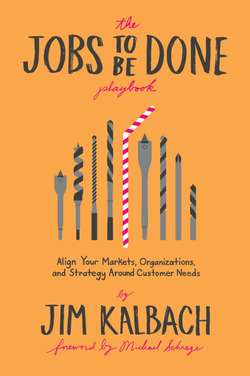Читать книгу The Jobs To Be Done Playbook - Jim Kalbach - Страница 28
На сайте Литреса книга снята с продажи.
Needs
ОглавлениеWhy do the job performers act the way they do while getting the job done?
Working with needs is challenging, in general. The term itself has many connotations and defies precise definition. In some cases, such as in software development, a “need” is interpreted as a system requirement. For instance, user stories in Agile methodologies describe what users need to have in place in order to interact with a system.
In other cases, such as with voice of the customer research, a “need” is a benefit a customer gets from a given product or solution, e.g., customers need to have quick and easy access to support. And in yet other situations, such as with Design Thinking techniques, a need is seen as a fundamental human motivation, e.g., people need personal fulfillment. Without a common understanding and clear definition of what a need is, conversations within teams and organizations can go astray quickly. It’s no wonder there isn’t agreement on what a need is exactly.
JTBD helps in two ways. First, in JTBD a “need” is seen in relation to getting the main job done. Needs aren’t demands from a solution, but an individual’s requirements for getting a job done. For instance, if a main job is defined as file taxes, needs in getting that job done may be minimize the time it takes to gather documents or maximize the likelihood of a getting a return.
From this standpoint, needs aren’t aspirations either, which are above the main job in terms of abstraction. Expressions like “have financial peace of mind” or “provide for my family” are motivations beyond getting the main job. These are important aspects to consider later, but not needs related to reaching the objective of filing taxes.
Second, JTBD provides a consistent pattern for expressing needs, as described earlier in the chapter: verb + objective + clarifier. This normalization allows for consistent ways of pinpointing opportunity. Semantics matter. Without a clear, concise formulation of what a need is, interpretation is up in the air.
Think of the job as the overall object or aim and needs as the success criteria along the way. As with job statements, formulating a need statement in a standard way is critical. Lance Bettencourt and Anthony Ulwick have developed a consistent way to notate needs in what they call desired outcome statements. There are four elements:
Direction of change + unit of measure + object + clarifier
• Direction of change: How does the job performer want to improve conditions? Each need statement starts with a verb showing the desired change of improvement. Words like “minimize,” “decrease,” or “lower” show a reduction of unit of measure, while words like “maximize,” “increase,” and “raise” show an upward change.
• Unit of measure: What is the metric for success? The next element in the statement shows the unit of measure the individual wants to increase or decrease. Time, effort, skill, and likelihood are a few typical examples. Note that the measure may be subjective and relative, but it should be as concrete as possible.
• Object of the need: What is the need about? Indicate the object of control that will be affected by doing a job.
• Clarifier: What else is necessary to understand the need? Include contextual clues to clarify and provide descriptions of the circumstance in which the job takes places.
Consider the following examples of need statements in Table 2.3 for the job attend a conference.
TABLE 2.3 EXAMPLE NEED STATEMENT FORMULATIONS
| DIRECTION | MEASURE | OBJECT | CLARIFIER |
| Increase | the likelihood | of getting permission | from a boss to attend |
| Maximize | the ability | to remember relevant content | from conference presentations |
| Minimize | the time it takes | to summarize conference insights | for sharing with colleagues |
| Maximize | the likelihood | of networking with thought leaders | in the field |
A strength of the JTBD approach is that it separates goals from needs. Consider the job as the target that someone wants to get done, and the need as the measure of success or the expected outcome. For instance, the statement “speed up the next big promotion at work” mixes goals and needs. In JTBD terms, the job is simply to get a promotion. Needs in completing that job are to minimize the time it takes to get promoted and increase the size of the promotion.
If you find yourself using an and or or, you probably need two separate need statements. Need statements should be as atomic as possible to not only see all of the factors involved in getting a job done, but also to pinpoint which ones are most important. As a result, any main job may have 50–150 intended needs.
For instance, there may be many needs for the main job of prepare a meal, such as minimize time to process ingredients, reduce the risk of injury, increase the likelihood that others will enjoy the meal, or minimize the effort to clean up after the meal. The list goes on.
